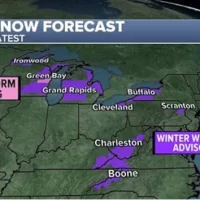
(NEW YORK) — Hurricane Milton is forecast to bring a slew of devastation to Florida’s west coast as the Category 3 storm makes landfall in the Tampa area Wednesday evening.
In addition to physical damage to the region, power blackouts and cell service outages could last for days after the storm hits, as was seen in the wake of Hurricane Helene late last month.
As residents prepare for impact, there are several satellite connection options available for the latest iPhone and Android models to facilitate contact with loved ones and emergency personnel in the face of outages.
iPhone
With iPhone 14 or more recent models, users can connect devices to a satellite to text emergency services, request roadside assistance, message friends and family and share locations, even without cellular and Wi-Fi coverage, according to Apple.
However, because satellites are located hundreds of miles away from Earth and move rapidly the user experience may be impacted by the low bandwidth, according to the company.
“In ideal conditions with a direct view of the sky and the horizon, a message might take 30 seconds to send. It might take over a minute to send under trees with light or medium foliage,” the company notes on its website.
Apple recommends being outside with a clear view of the horizon, moving away from obstructions such as trees, sending shorter messages and updating to the latest IOS for best results.
To connect to a satellite, swipe down from the top right corner of your iPhone to open Control Center, then tap the Cellular button on the right. Tap Satellite, then choose a satellite feature.
Ahead of the storm and for emergencies at large, Apple recommends having emergency contacts and important medical information added to your Medical ID within the Health app.
Android
For Android users hoping to connect to Google’s satellite services, the models with the capability include the Pixel 9, Pixel 9 Pro, Pixel 9 Pro XL, and the Pixel 9 Pro Fold.
Called Satellite SOS, “This feature will be activated once all the necessary software and APIs are updated and the service is registered with the satellite network,” according to Google.
The company says users will be notified once the feature is active but the status can be checked in the settings app.
On the Pixel models listed above, if you need to contact emergency services without a mobile or Wi-Fi network, dial 911 and you’ll find an option to use Satellite SOS in the dialer.
Tap Satellite SOS and then press start, from there you’ll fill out the emergency questionnaire.
To set up emergency contacts to receive updates on your location and status when using Satellite SOS, Android users should go to the phone’s Personal Safety app.
Starlink
In a collaboration with T-Mobile, Elon Musk’s Starlink is offering direct-to-cell service for areas expected to be impacted by Hurricane Milton.
“We have accelerated the rollout of Starlink direct to cell phone connectivity for areas affected by the hurricanes,” Musk wrote on X early Wednesday morning. “This is being provided free of charge by SpaceX and TMobile to help those in need,” he added.
New users can activate Starlink for free and the service will work for carriers outside of T-Mobile, according to Musk.
If a phone connects to a Starlink satellite, it will have one to two bars of signal and show “T-Mobile SpaceX” in the network name, according to SpaceX.
“Users may have to manually retry text messages if they don’t go through at first, as this is being delivered on a best-effort basis,” the company wrote on X.
“The service works best outdoors, and occasionally works indoors near a window,” SpaceX added.
Copyright © 2024, ABC Audio. All rights reserved.















